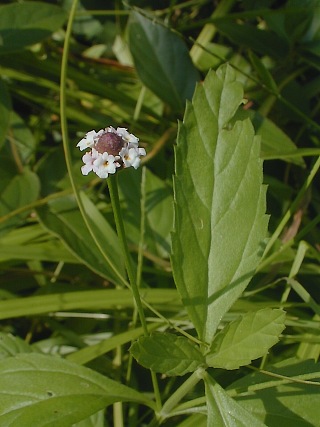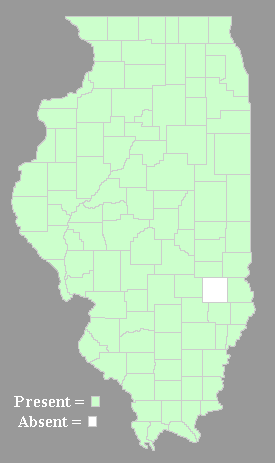Description: This herbaceous perennial plant is ½–2' tall, branching occasionally. The stems are erect, or they may sprawl along the ground and root at the nodes. The opposite leaves are up to 3" long and 1¼" across. They are ovate or ovate-lanceolate, with short petioles and wedge-shaped bottoms. The margins are coarsely serrate to a little below the middle of each leaf, with 5-10 teeth per side. Both the stems and the leaves are usually hairless; sometimes the leaves are slightly pubescent. From the axil of each upper leaf, there often develops a stalk terminating in a short spike of flowers. These flowering stalks are often longer than the leaves.

The flowers are
arranged in whorls around the spike,
which eventually becomes up to ½" long. Each flower is about 1/5"
across, consisting of a corolla with 5 lobes (the lowest corolla is
wider than the others). The corolla is white, light pink, or light
purple, with a small patch of yellow or rosy pink near the throat of
the flower. The blooming period occurs during the summer and lasts
about 1-2 months. The seed capsule has 2 cells, with a pair of small
nutlets in each cell. The root system produces long rhizomes. This
plant often forms dense vegetative colonies by means of the rhizomes or
by rooting at the nodes of the leaves.
 Cultivation:
The preference is full or partial sunlight, slightly wet to moist
conditions, and a rich soil with lots of organic matter. The foliage
remains attractive and is little bothered by disease. This plant can
spread aggressively in an open situation that is sufficiently sunny and
moist.
Cultivation:
The preference is full or partial sunlight, slightly wet to moist
conditions, and a rich soil with lots of organic matter. The foliage
remains attractive and is little bothered by disease. This plant can
spread aggressively in an open situation that is sufficiently sunny and
moist.
Range & Habitat:
Fogfruit is a common plant that occurs in nearly every county of
Illinois, where it is native. Habitats include wet black soil prairies,
seeps, areas in or
around ditches, powerline clearances in floodplain forests, and moist
depressions in yards. This species is more common in degraded wetlands
where there is a history of disturbance.
Faunal Associations:
The nectar of the flowers attracts various insects, including
bumblebees, leaf-cutting bees, Epeoline cuckoo bees, long-horned bees,
green metallic bees and other Halictid bees, Syrphid flies, bee flies,
thick-headed flies, Tachinid flies, small butterflies, and skippers.
Some of the Halictid bees also collect pollen. The foliage and
seedheads are eaten by Canada Geese. Little information appears to be
available about this plant's role as a food source to mammalian
herbivores.
Photographic Location:
A powerline clearance in Busey Woods at Urbana, Illinois. Fogfruit also
occurs in ditches, yards, and degraded wetlands in the area.
Comments: This
little plant is easy to overlook, except where it occurs in large
colonies. It is not particularly showy. An older scientific name for
this species is Lippia lanceolata, and in some
older references 'Frogfruit' is provided as a common name. There are
two other Phyla spp. (one from the west, the other
from the south), but they aren't native to Illinois and rarely
naturalize within the state. The leaves of these two species are more
narrow, with 1-3 teeth occurring on each side of a leaf above the
middle. Fogfruit has 5-10 teeth on each side of a leaf, and some of
these teeth occur below the middle of the leaf margin.